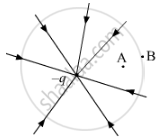Advertisements
Advertisements
प्रश्न
What is the amount of work done in moving a point charge Q around a circular arc of radius ‘r’ at the centre of which another point charge ‘q’ is located?
उत्तर
The work done in moving a charge along any circular path is zero. So, to move a point charge Q around a circular arc of radius ‘r’ at the centre of which another point charge ‘q’ is located, no work has to be done.
APPEARS IN
संबंधित प्रश्न
The field lines of a negative point charge are as shown in the figure. Does the kinetic energy of a small negative charge increase or decrease in going from B to A?

Why must electrostatic field at the surface of a charged conductor be normal to the surface at every point? Give reason?
The bob of a simple pendulum has a mass of 40 g and a positive charge of 4.0 × 10−6 C. It makes 20 oscillations in 45 s. A vertical electric field pointing upward and of magnitude 2.5 × 104 NC−1 is switched on. How much time will it now take to complete 20 oscillations?
A charged oil drop weighing 1.6 x 10-15 N is found to remain suspended in a uniform electric field of intensity 2 x 103 Nc-1. Find the charge on the drop.
An electron falls from rest through a vertical distance h in a uniform and vertically upward directed electric field E. The direction of electric field is now reversed, keeping its magnitude the same. A proton is allowed to fall from rest in it through the same vertical distance h. The time of fall of the electron, in comparison to the time of fall of the proton is ______.
Electric lines of force about negative point charge are ______
Consider two identical point charges located at points (0, 0) and (a, 0).
Is there a point on the line joining them at which the electric field is zero?
An isolated point charge particle produces an electric field `vecE` at a point 3 m away from it. The distance of the point at which the field is `vecE/4` will be ______.
